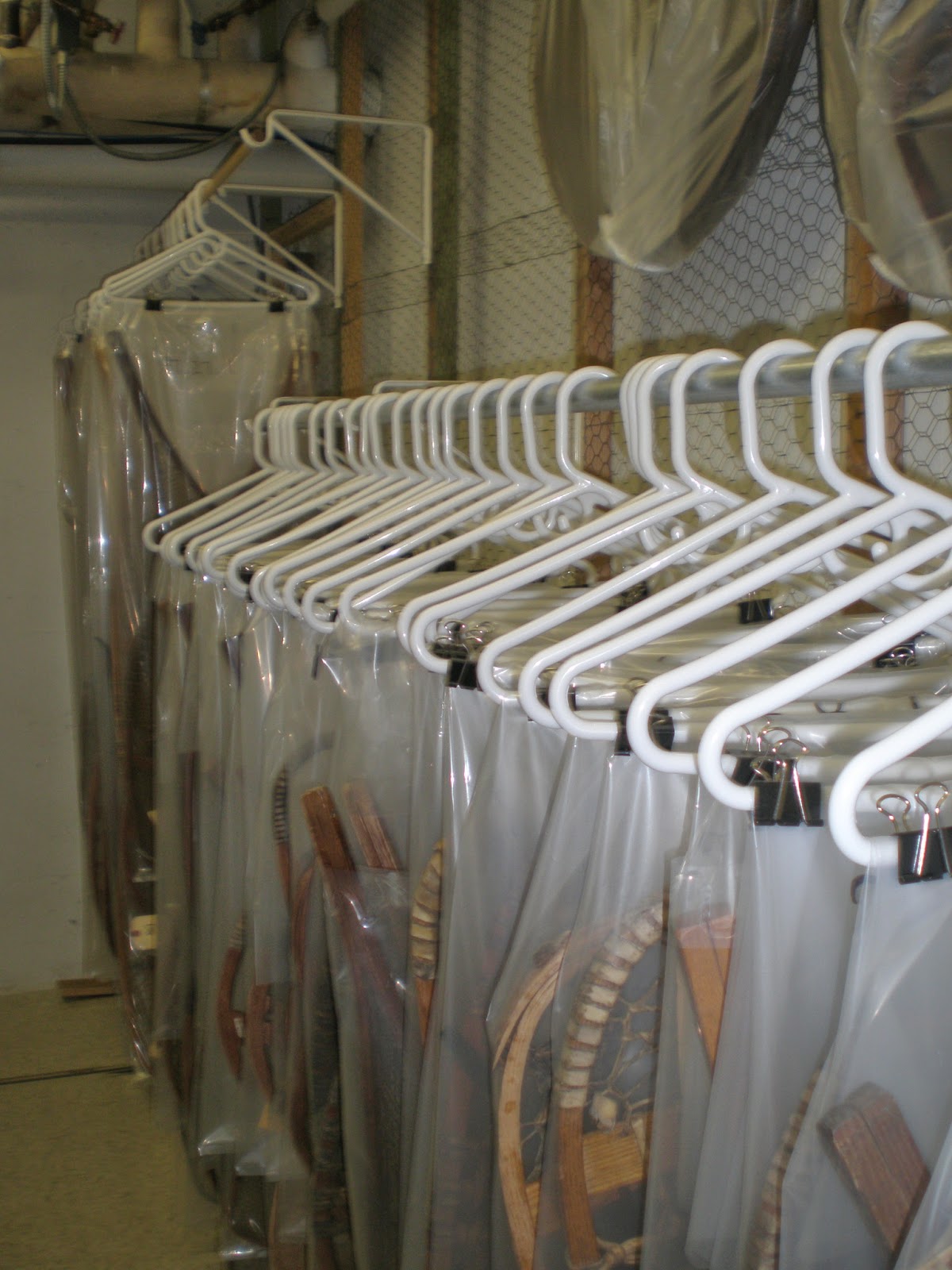Whether it is a silk dress from 1840, or a military jacket from the Civil War, or perhaps a christening gown passed down through generations, historic costume is is an important part of any textile conservator's work. Too often, garments are brought to us in a condition that could have been prevented. The damaging item is sometimes a surprise, as not everyone knows the dangers of acid migration and that the natural organic wooden hanger supporting the prized garment is the thing that is doing the most harm. Wooden hangers, while very sturdy, are made of wood which is quite an unfriendly companion to textiles (as evidenced below). (See Glossary of safe materials for storage).
 |
| The light color of this jacket lining allows the staining from the hanger to be quite visible |
But let us not point an accusing finger to wooden hangers only. It is not just the material a hanger is made of, it can simply be the hanger itself. Perhaps the item is too fragile to hang, or the hanger is far too big for the tiny garment and the arms have been forced out to the side rather than to hang naturally from the shoulders, or perhaps the heaviness of the garment causes undo stress to the fabric at the shoulders, resulting in weekend areas now prone to tears. Another contributing factor is the thickness of the hanger, a thin wire hanger is not as supportive as a thick molded polystyrene hanger, simply because the thicker hangers ease the distribution of weight across a larger area, while the wire creates specific and unforgiving stress points.
Creating padded hangers might seem like a daunting task, especially to the curator of the historical society with walls lined with racks holding innumerable garments, all hanging from wood, plastic, or those lovely but quite thin wire hangers (a la dry cleaner). I know, you are thinking about dry cleaning bags now too, you are thinking how you've seen them covering antique garments and you know it's wrong…we will talk about this later.
To get started, evaluate the garment you would like to hang, determine the proper type of padded hanger design, and gather your materials. Since the initial idea of a padded hanger back in the 1970s, hangers have come a long way. Conservators and collection managers now have far more options to the original design than ever before. But in all cases, they follow the same simple rules.
RULE #1: A textile should NOT be hung if it is fragile, or if the hanger causes strain on the garment. These more delicate textiles must be boxed and padded out to prevent crushing from folds. Read more about boxed storage of textiles in our blog post about proper storage and support of textiles .
RULE #3: Selecting supplies and materials is critical to constructing your padded hanger. All materials need to be archival: inert, neutral pH, and will not off-gas.
RULE #4: Never hang knits. Just don't. They will stretch and sag and then the damage is irreversible, so just avoid it all together.
How heavy is the garment you are hanging? Robes, coats, capes and heavily adorned costumes are particularly heavy. Evaluate these appropriately with consideration to the strain on the shoulders to hold all that weight.
There are some other advantages to padded hangers. The material that covers the hanger provides a gripping surface so the garment can "hang on" and not shift much once it is placed on the hanger.
Hangers not only come in different sizes, there are other shapes as well. The Pants hanger, or the strait style hanger with clips is another frequently used item that needs re-evaluation. The clips are just too harsh, they cause crushing, severe pressure points, and usually sagging of the garment in between the clips. The alternative here is the hanger that works more like a strait clamp. These types of hangers can also be padded and provide support that is evenly distributed, this is a much more gentle approach. But keep in mind the length of the hanger and the what it is supporting. If the waist of a skirt extends well past the clamp edges, it is too large for this type of hanger and is not being properly supported.
The wonderful thing about padded hangers is that they don't have to be expensive. In fact, I am reminded of the Canadian War Museum's ambitious project back in 1999, when they had a backlog of 15,300 (!) clothing items. They needed a quick, archival acceptable, but inexpensive solution and came up with what they dubbed "insta-hangers". Using 1" pipe insulation made from closed cell polyethylene, they covered hangers and got to work. Ingenious!
Need some illustrated instructions to create your own padded hangers? Lots can be found on-line. Here is a link to Minnesota Historical Society's instructions for making a padded hanger: http://www.mnhs.org/preserve/conservation/reports/paddedhanger.pdf
Also, a step-by step method for creating padded hangers as well as cotton muslin coverings from blogger, Sara who works as a curator:
And last, but not least, the NPS Conserve O Gram from 1994:
In our next blog we will discuss dust covers and how they keep unwanted things (i.e. dust, debris, cat hair, etc…) off of your textiles.
_____________________________
Gwen Spicer is a textile conservator in private practice. Spicer Art Conservation specializes in textile conservation, object conservation, and the conservation of works on paper. Gwen's innovative treatment and mounting of flags and textiles is unrivaled. To contact her, please visit her website.







Very helpful, thank you so much!
ReplyDeleteWhat brand of hanger do you recommend for a 70 year old film costume suit coat?
ReplyDelete